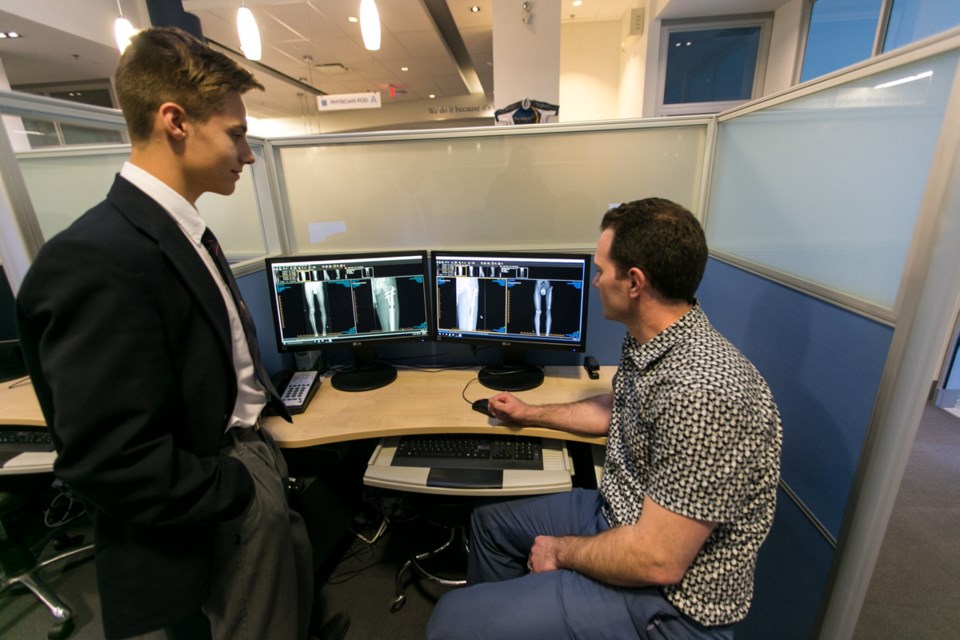Not every teenager wants attention, but Matthew Gordon found it hard to avoid with an external bone-lengthening apparatus attached to his leg.
The equipment represented much more than esthetics, however: There was serious pain, plus a reminder of the severe limp that came with having one femur shorter than the other, the consequence of a bone infection in his infancy.
A new device — one hidden from view inside his leg — has changed that.
Today, the 14-year-old skips down stairs, surfs and plays fullback on his rugby team.
“My left leg is still a bit weaker than the other,” he said.
“It’s always been that way because of the discrepancy in my femurs. But I can just do whatever I want now.”
Matthew was the first in British Columbia to benefit from a new bone-lengthening technology. He told his story in hopes of boosting the Victoria Hospital Foundation’s campaign to raise $1.8 million for 72 pieces of surgical equipment.
His condition began when he was three weeks old.
“One day my mom woke up and saw me in the crib and I had a swollen knee. My bone had ruptured,” Matthew said. The infection meant his left femur stopped growing.
For years, he travelled to Vancouver for care. By the time he met Victoria-based orthopedic surgeon Dr. Brent Weatherhead, his left leg was about eight centimetres shorter than his right.
He was using the external apparatus to lengthen the femur, but Weatherhead had another idea: He’d heard about a new technology at an international conference on orthopedics.
“We were waiting for the technology to be available in Canada, so I put Matthew off for a little while,” Weatherhead said.
“I always take a cautious approach to new technology, because not every new technology is great. … I didn’t want to jump in too early and find out it was a total disaster, so we waited until we had enough science behind it.”
With the external apparatus, Matthew had to turn screws that pass through skin, muscle and bone — four times a day. It was prone to infection and cleaning, in itself, was very painful.
“It’s a little bit archaic when you look at it, and the pins are kind of dragging through the skin and muscle, so there’s a lot more pain,” Weatherhead said.
The new device, called a precise nail, was different: It’s all inside.
“What it allowed us to do was put a lengthening rod inside Matthew’s femur, so it’s all buried under the skin,” Weatherhead said.
“It’s done basically through three poked holes on the side of his leg.
“Then through a magnet, which is on the internal device, and a controller that Matthew is given for a period of time, he can control the lengthening.”
Not having anything stick out of his skin meant benefits beyond avoiding pain and infection.
“Socially, Matthew looks like a normal kid, nobody really has to know he’s going through this process,” Weatherhead said.
“It just allows him to continue participating in all the things he wants to participate in.”
Matthew underwent surgery to insert the nail in December 2015. The lengthening of 7.5 centimetres took 21Ú2 months.
By summer, he was celebrating by surfing.
The technology means children in similar situations don’t have to leave Vancouver Island for treatment, Weatherhead said. He already has a list of other families interested.
Beyond the new technology, he said, every orthopedic surgery requires some basic tools, which the Victoria Hospitals Foundation is raising funds for.
On the foundation’s wish list are 18 orthopedic power saws and drills, which cost $9,925 each, for a total of $178,650.
“It’s great to talk about the nail that goes in, but I can’t do that without the basic instruments,” Weatherhead said.
• Contributions to the Victoria Hospitals Foundation can be made online at victoriahf.ca, by phone at 250-519-1750 or by mail to Wilson Block, 1952 Bay St., Victoria, B.C., V8R 1J8.



